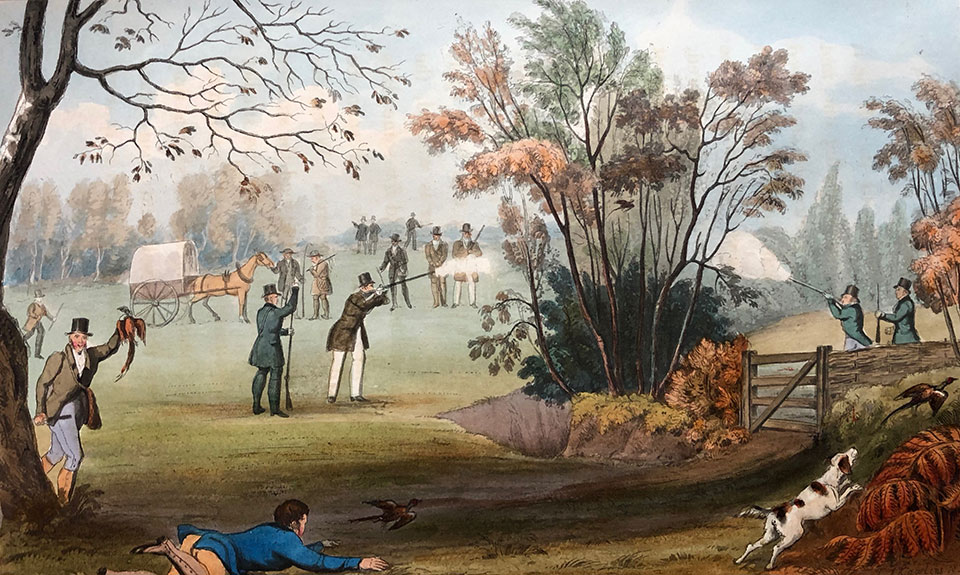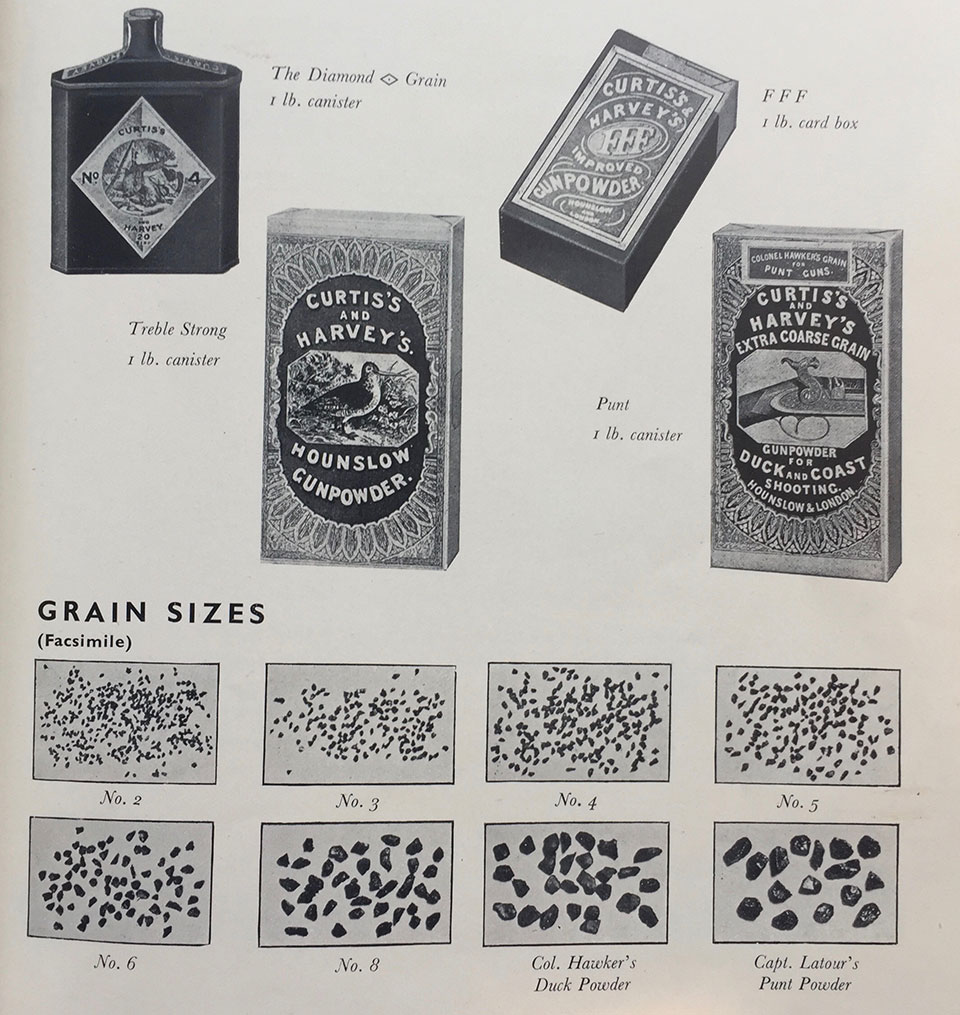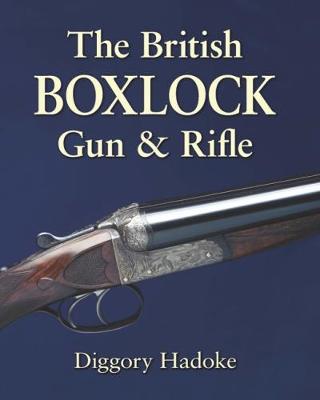My shooting career began when old-fashioned sportsmen still used black powder, and more progressive ones were trying out the new “ sawdust ” powder, which at first was held in small esteem because it had little “ kick ” in it.
A majority of keepers still used muzzle-loaders at that time, and some of the old, long, single-barrelled 14-bore muzzle-loaders of the period were real long-range weapons. In those days, red deer calves were walked-up like hares and shot with shotguns, more to thin out the deer than for eating purposes, and the particular single-barrelled muzzle-loader I have in mind was, including its stock, as long as a man. It was a ponderous weapon, but, used with Curtis’s and Harvey’s black powder, it was a great weapon to throw the larger sizes of shot in a pattern to kill deer and large birds, like eagles or geese, at long ranges.
This type of single-barrelled muzzle-loader was modelled on the older flint-locked Spanish guns, an historical specimen of which weapon was a family heirloom. This old Spanish gun had a castle engraved on its breech, and as I tried it out at a distant couple of mallard on one occasion, I know that it was a real long-range weapon, for, with No. 2 shot, at a distance beyond which I would fire at duck with a modem shotgun, it knocked over both duck, one dead and one winged.
That was a small feat for the old gun, which in ancestral hands had brought down scores of stags with ball and, it was said, seven of King George’s soldiers at the Battle of Culloden.

There were several double-barrelled muzzle-loaders at my father’s disposal in the early days of my boyhood and some were gold-mounted and engraved, but my favourite, when I went rabbit-stalking, was a 14-bore by Martin, Glasgow, which my father did not like because it smashed grouse and rabbits at close ranges. That was the weapon for my stalks, for, rested on a tank, or on my cap on a rock, it never failed to bowl over distant rabbits, like the lighter, meaner weapons of the same bore which I used sometimes.
A recent letter in the Shooting Times suggests that the smell from black powder must have been unpleasant, but in the old days Curtis’s and Harvey’s best Diamond grain had little smell or smoke, and less expensive powders by the same and other makers both smelled and smoked abominably.
It was when one was cleaning a muzzle-loader with hot water that one got the full aroma of the powder, and the keeper of those days had a long job cleaning The guns, of a shooting party. His washing-rod was deeply scored at one end, to hold wrapped tow to fit the bore, and, having placed the breech of a gun in a bucket of hot water* he worked the rod in piston fashion, using fresh hot water until the water scooted” from the nipples of the gun in a clear condition.
The gun barrels were now dried inside and out and stood by the gunroom fire to- dry, when a tow, with a very little oil on it, was wrapped on the end of a dry rod and rubbed up and down inside the barrels. The outside of the barrels were oiled lightly, and if the party had been caught in heavy rain, the locks of the weapons were unscrewed and thoroughly dried and seen to. Keepers of those days put the lock parts of their guns under their coats (at the right-hand side) at any shower of rain, so that the locks (of a careful keeper’s gun) seldom needed taking off.
In those days, as in more modem ones, many unthinking sportsmen took no care at all to keep heavy rain out of the mechanism of their weapons and so gave (and give) the careful keeper needless trouble.
It was a great day for me when, armed with an under-lever breech-loader which a friend had lent me, and with twelve blue-cased Eley cartridges in my pocket, I accompanied my father in his search for some game for the Lodge. My cartridges were loaded with No. 4 shot and snipe were wanted, so I was rather out of it at first, owing to my belief that snipe would escape in the middle of my charges, even if I fired.
I was loath to waste cartridges on snipe too, as I had never tried a shot at one, but finally let go at a crossing snipe, missing it with my first shot but knocking it over with a hurried second barrel. Next time I fired, I took a steady long, low swing and missed again, to make a bullseye with my second, by means of a desperately fast effort of swinging.
We wanted hares also, and presently I saw one sitting and would have shot as it sat, but for the watchful eye of my father who made me walk it up. A steady aim with my first, and no result; a desperate race of the gun for a “ forlorn-hope ” try, and over poor puss went.
My father now advised me to try to kill with the first barrel. “Take a little more time,” he said, “and don’t be aiming at them as if ye had a rifle. Fire your first barrel as you fire your second when you kill, or shooting will be an expensive game for you.”

Black powder certainly did spoil second barrel shots to some extent, but only on very calm days when one might have a difficulty in seeing through the cloud belched out by one’s first shot. As I have said, the best brands of black powder had little smoke and rather a pleasant odour, but the man who used cheap black powder cartridges was a decided nuisance to his fellow-guns who were situated to leeward of him.
We had covert shoots in the days of black powder, and, attending on a rather testy old gentleman at one, he declared himself nearly suffocated by the barrage put up by our nearest neighbour on the windward side. When the beat was over, Mr. “Testy” told me to go over to see Mr. S-before he began to shoot at the next stand and ask if he would be good enough to use some other brand of cartridges, as his neighbours to leeward were doubtful whether they could survive an ordeal like that of the last beat.
Reaching Mr. S in due course, I said: “Mr. ‘Testy’ wishes me to ask you if you can stop using those cartridges of yours, as he was nearly suffocated and blinded by the smoke from them at the last beat.“ Are they really so bad as all that? Please tell Mr. ‘ Testy ’ that I am so sorry about it and that I will use no more of those cartridges, which are only a few I have kept for a long time in a drawer.”
On reporting to Mr. “ Testy,” he remarked: “ Kept them a long time in a drawer, did he? They smell like that certainly.”
This piece was dictated by an anonymous old gamekeeper in the late 1930s. Assuming he was then in his seventies, his boyhood would have been during the 1870s.
Published by Vintage Guns Ltd on



